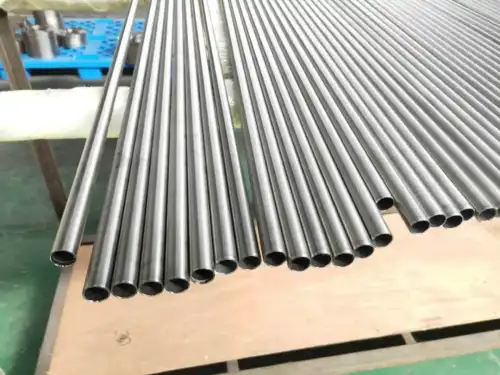The main differences between cold-rolled titanium tubes and hot-extruded titanium tubes are as follows:

1. Production process
- Cold-rolled titanium tubes
Cold rolling is the rolling process of titanium tubes at room temperature. Through multiple rolling, the diameter of the titanium tube is reduced and the wall thickness is thinned. This process requires greater pressure and precise control of rolling parameters, such as rolling speed and rolling force.
For example, when producing some high-precision titanium tubes for aerospace, the cold rolling process can ensure that the dimensional accuracy of the tube is within a very small tolerance range.
- Hot extruded titanium tubes
Hot extrusion involves heating the titanium billet to a certain high temperature (usually higher than the recrystallization temperature of titanium), then putting it into a mold and applying pressure through the extrusion rod to extrude the titanium billet into a titanium tube according to the shape of the mold.
For example, when producing large-diameter and relatively simple-shaped titanium tubes, the hot extrusion process can efficiently form them.
2. Performance characteristics
- Cold-rolled titanium tube
High dimensional accuracy: its tolerance can be controlled within a very small range, for example, the outer diameter tolerance can reach ±0.05mm or even smaller.
Good surface quality: the surface of the cold-rolled titanium tube is smooth and flat, which reduces the difficulty of subsequent processing.
Mechanical properties: due to the work hardening effect during the cold rolling process, its strength is relatively high, but the plasticity will be reduced.
- Hot-extruded titanium tube
Good uniformity of organization: high-temperature extrusion makes the grains inside the titanium tube arranged along the extrusion direction, and the organization is more uniform, which is conducive to improving the comprehensive performance of the titanium tube.
Complicated shapes can be formed: titanium tubes with special cross-sectional shapes can be produced, such as titanium tubes with reinforcing ribs or irregular shapes.
Relatively balanced performance: the difference in mechanical properties such as strength and plasticity is not as obvious as that of cold-rolled titanium tubes, and it is more suitable for some application scenarios with high requirements for comprehensive performance.
3. Application fields
- Cold-rolled titanium tubes
Widely used in fields with extremely high requirements for dimensional accuracy and surface quality, such as pipeline systems in high-end chemical equipment, pipeline connections in precision instruments, and meters etc.,
- Hot extruded titanium tube
It is widely used in marine engineering equipment (such as pipes in seawater desalination equipment), automobile engine cooling systems, and other fields. These fields require titanium tubes to have good comprehensive performance and be able to adapt to complex working environments.
4. Cost
- Cold-rolled titanium tube
Due to high equipment requirements and strict processing precision control, the production cost of cold-rolled titanium tubes is relatively high.
- Hot extruded titanium tube
Although hot extrusion equipment is also relatively expensive, the unit cost is relatively low when large-diameter or simple-shaped titanium tubes are mass-produced.
Summary:
The above are the differences between cold-rolled titanium tubes and hot-extruded titanium tubes. I hope it can help everyone. If you have any questions, please feel free to consult us.











